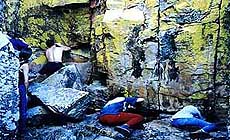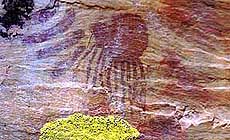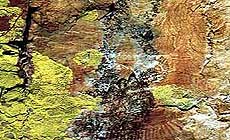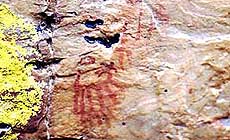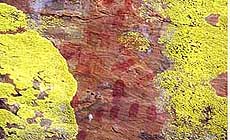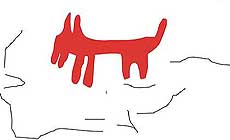 |
Description: |
Engravings
Paintings
Painted engravings
High or low-relief
Sculpture
In this rock shelter, among several blots, remains of colour, incomplete bars and finger dots, we can point out other typified figures. There are several zoomorphs technically diverse, distributed among several groups of figures. The first one, found isolated, is composed by an horizontal thick line from where arise nine appendixes that indicate several anatomic details (ears, tail, legs and muzzle). It's 5,5 cm high and 9 cm length. On the other hand, we can see two more zoomorph schemes traced thinly. The firts is incomplete for headless, though we can distinguish the trunk, the legs an the curved tail. The second, placed right below, is quite depigmentated and shows hindquarters and tail and remainings of posible neck and head. Both are arround 2 cm high and 3 cm long and red coloured. Next, after an indeterminate blost, irregilar and clarly incomplete and degraded, we find a group of ancor shaped figures and two arrow shaped motives, between 1- 2 cm long and thin traced, among several indeterminate remains of colour. In one of the ancor anthropomorphs we can see a graphite line in its right side. Next two groups of badly preserved figures, depigmentated and affected by lichen, show no definible type. The sixth and seventh agroupations, though separated a few meters, show complex figures; first group, from up to down, has 4 ancor shaped anthropomorphs, thin traced and very stylized on their upper part, lower part is not defined for they end thick traced (1.5 cm thick- 4 cm long). Below, after a little oval and 3 vertical incomplete thin traces that could have been other ancor shaped antropomorph, there's a complex figure composed by two adossed lcomb-shaped figures of thin traces whose upper ends seem to have conected on each side two strange appendixes of much darker red colour. It is 2.2 cm long.-1.5 cm wide. Beneath them, after a blost, we see an oval smudge with over 30 thin appendixes, 0,2 cm wide, arising on the lower side. Next group contains, among horizontal curved thick lines 2 more oval appendixed figures -from 2,6 cm to 6,5 cm long;thin lines, from 1 cm to 3 cm long- and one stylized ancorshaped anthropomorph, 3 cm long, with legs and male sex indicated, next to 2 comb shaped motives, max 2 cm long, one on top of the other and several smudges. Last, we find severallong thick bars and other little comb-shaped figure.
|
Figures: |
total number 79
3 Zoomorph, bar, blot, upside down U-shaped, angle, indeterminate, finger spots, 3 oval appendixed figure, reticle, 3 comb-shaped figure, swallow-like ancor anthropomorph, ancor anthropomorph.
|
|
 |
Chronology: |
Palaeolithic
Epipalaeolithic - Mesolithic
Neolithic
Copper Age
Bronze Age
Iron Age
Roman
Middle Age
Modern
Unknown
4.000-600 BC.
|
Notes: |
General paintings found show us pigment remainings. Just a few appears with good conservated pigment, and analysis about the composition of the red ones have shown mineral procedence from iron oxide, very common on the area.The rock wall was discovered during the prospection made by Colectivo Barbaón in 1997. |
|
 |
 NEW: Alpine rock paintings
NEW: Alpine rock paintings